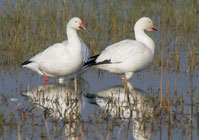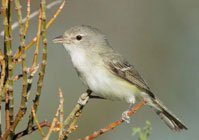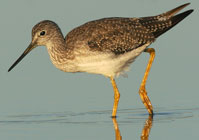Accomplishments
The CVJV partnership has earned an impressive record of accomplishment since its inception in 1988, and is making great progress towards meeting the objectives identified in its 2020 Implementation Plan.

 Bell’s Vireo
Bell’s VireoBy Greg Yarris, Science Coordinator
Central Valley Joint Venture

The 2006 CVJV Implementation Plan (Plan) was a leap forward relative to past plans in several respects. As mentioned in the previous article, the scope of planning was expanded to incorporate bird groups other than waterfowl. As a result, the Plan became a comprehensive document for migratory bird conservation in the Central Valley and is used extensively as a resource for habitat planning. In addition to adding other bird groups, the waterfowl component of the Plan was also improved considerably. During the 16 years since the 1990 plan was completed, Joint Venture partners had invested heavily in research to evaluate the biological assumptions upon which the waterfowl component of the Plan was based. This investment considerably strengthened the biological foundation of 2006 Plan.
An important factor determining the past and continued success of the CVJV is the reliance on and adherence to good science in conservation planning. Science is employed at multiple levels; basic biological information about avian species and their habitats is important for initial planning, and periodic evaluations and monitoring is critical for testing assumptions as well as determining the biological outcome of our efforts. The process is iterative, and new data informs conservation planning decisions moving forward. This type of approach has many labels, but is typically referred to “Adaptive Resource Management”, a specific form of which has been adopted by the US Fish and Wildlife Service (Strategic Habitat Conservation). The strategy acknowledges the uncertainty in our planning decisions, and allows for future adjustments based on new knowledge as it becomes available through evaluations.
The next update of the Plan will demonstrate an even greater commitment to science and further refinement of population and habitat objectives. This is largely due to the significant efforts of working groups that were convened to focus on the bird groups represented in the Plan. There are three existing bird-focused working groups; a Waterfowl Working Group, a Shorebird/Waterbird Working Group, and a Riparian Songbird Working Group, with the expectation that in the near future a Grassland Bird Working Group will form. The groups are led by and comprised of avian experts from agencies and NGO’s from the CVJV, as well as individuals who have unique or regional knowledge. In 2010, the working groups finished a major milestone; the first CVJV Monitoring and Evaluation Plans for each bird group. The documents identified future monitoring and research needs, and also ranked them based on their contribution to improving conservation delivery in the Central Valley. Progress made on those priorities has been significant, and this knowledge will vastly improve the ongoing revision of the CVJV Implementation Plan.
The CVJV is fortunate to be represented by partners who realize the value of science. Nearly all of our partner organizations and agencies have biologists on staff who are actively engaged on our various working groups and committees. These individuals organize and attend numerous meetings, conduct key research on priority migratory bird issues, and author many of the CVJV planning documents. The dedication of our partners ensures the revised Plan will be built on a foundation of science, and that limited financial resources are used as efficiently as possible and where it is needed most when the new Plan is implemented.
The CVJV partnership has earned an impressive record of accomplishment since its inception in 1988, and is making great progress towards meeting the objectives identified in its 2020 Implementation Plan.

Follow these links to learn about some of the important bird conservation work happening in California's Central Valley.
